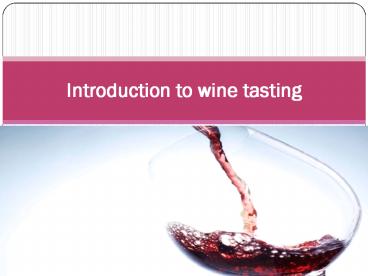Introduction to wine tasting - PowerPoint PPT Presentation
Title:
Introduction to wine tasting
Description:
More often, wine tasting events are done on specific days of the week and when bigger groups are to attend to attend these events; they are required to make reservations so that proper arrangements can be made and also adequate staffs to be provided by the winery. – PowerPoint PPT presentation
Number of Views:1349
Title: Introduction to wine tasting
1
Introduction to wine tasting
2
- When the winery involved is small such as those
owned by a single family entity, the customers
get a chance to interact with the wine maker and
helpful tips are provided on the whole wine
making process.
3
- More often, wine tasting events are done on
specific days of the week and when bigger groups
are to attend to attend these events they are
required to make reservations so that proper
arrangements can be made and also adequate staffs
to be provided by the winery.
4
History of wine tasting
- Wine tasting date back to many years and has the
same genesis as the wine making itself. During
these events customers get to learn a lot about
wine such as the different flavors and aromas.
5
- Most individual tend to think that the whole
process is as simple as sipping tea or coffee but
along the way different stages have been
established for this process
6
(No Transcript)
7
Tips for wine tasting
- Certain conditions such as noisy environments,
presence of perfumes odors such as that coming
from people sweats may adversely affect the
evaluation of wine through tasting.
8
- While observing the wine to be evaluated
individuals should ensure that the glass is half
full, they should tilt it to allow the wine to
roll on the edges of the glass, hold the tilted
glass to the light.
9
- This procedure is mainly for evaluation of wines
color range. To achieve this, the person tasting
the wine should ensure that they obtain an angle
view.
10
(No Transcript)
11
- Smelling should be done by first swirling the
bottle to allow the wines alcohol to vaporize
and then a real quick whiff is taken. These helps
to create a better judgment of the smell of the
wine but for more complete judgments the taster
should ensure that their nose is down onto the
glass and then inhale.
12
- The tasting should involve the taster first
taking smaller sips and allowing it to be felt in
the mouth and the throat before taking another
bigger sip.
13
- At this point the taste should allow the wine to
settle on their stomach. Here the taste evaluate
the remnant of the wine left on the mouth,
evaluate it to know whether they are good tasting
or not, whether the wine is medium-bodied,
full-bodied or light-bodied.
14
- In conclusion it is always appropriate to leave
the tastes note which basically highlights your
judgments of the wine. Taster should not be
limited in expressing their feelings and should
use any word that better express their whole
judgement.
15
(No Transcript)
16
- The taster should include in their note, their
judgments on the acidity level, tannins and the
alcohol content. These are very helpful to the
wineries for improvement of their wines.
17
- Wine making is considered incomplete when the
wine tasting event is lacking, when wineries are
launching new brands of wines they usually
invites person to sip these brands and give their
honest judgments so that the wineries can know
what to add or reduce. Wine making is a journey
and wine tasting is one very crucial stage in the
development of high quality wines.
18
- For more information, visit us
http//kazzit.com/































